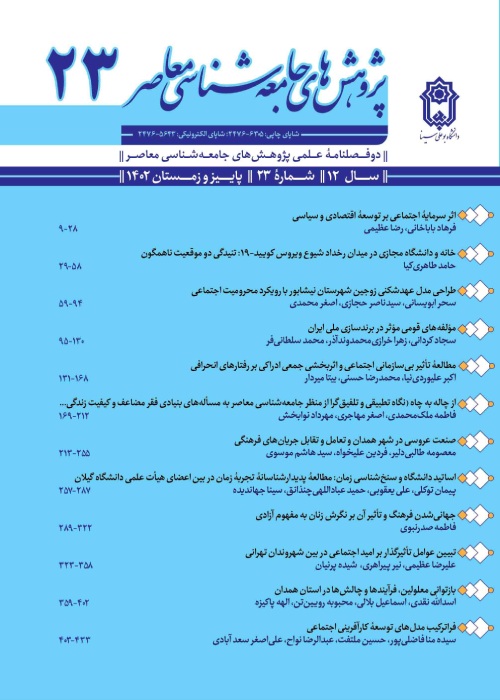Perception of Urban Residents towards Marginalized Populations; Coping Strategies of Residents in Affluent Areas of Mashhad City with Marginalization
Author(s):
Article Type:
Research/Original Article (دارای رتبه معتبر)
Abstract:
Disadvantaged settlements encompass areas that face various vulnerabilities and deprivations. These adversities give rise to the recognition of these areas as being plagued by “spatial stigma.” The nature of this spatial stigma is dynamic and permeates individuals, leading to their notoriety. Consequently, residents of these areas bear the burden of place stigma, which results in the attachment of diverse labels to them, prompting the adoption of various strategies to confront these challenges. The objective of this research is to explore the perception of marginalized individuals as seen through the eyes of residents residing in disadvantaged areas and to investigate strategies employed to address urban marginalization in the city of Mashhad. Employing a qualitative approach, the study utilized a semi-structured interview tool and implemented purposeful sampling and sample size determination based on the principle of informational saturation. The analysis of interviews followed the thematic analysis technique proposed by Braun and Clarke. The findings from 21 interviews with residents of disadvantaged areas in Mashhad reveal that marginalized individuals are perceived based on distinctive characteristics, including initial categorization (focused on livelihood, economic marginalization, self-sufficiency, and self-reliance), deviant behavior (undesirable traits and nonconformity), and a culture of marginalization (reactive behavior, self-neglect, informal upbringing, vernacular discourse, actions, and cultural capital of marginalization). These perceptions collectively contribute to the construction of “marginalization stigma.” The establishment and perception of marginalization stigma serve as the foundation for interactions with marginalized individuals, giving rise to two categories of strategies: “social accommodation” strategies, involving acceptance and engagement with marginalized individuals, and “social non-accommodation” strategies, entailing rejection and the establishment of boundaries in interactions with marginalized individuals.
Keywords:
Language:
Persian
Published:
Journal of Contemporary Sociological Research, Volume:12 Issue: 22, 2023
Pages:
205 to 238
magiran.com/p2628563
دانلود و مطالعه متن این مقاله با یکی از روشهای زیر امکان پذیر است:
اشتراک شخصی
با عضویت و پرداخت آنلاین حق اشتراک یکساله به مبلغ 1,390,000ريال میتوانید 70 عنوان مطلب دانلود کنید!
اشتراک سازمانی
به کتابخانه دانشگاه یا محل کار خود پیشنهاد کنید تا اشتراک سازمانی این پایگاه را برای دسترسی نامحدود همه کاربران به متن مطالب تهیه نمایند!
توجه!
- حق عضویت دریافتی صرف حمایت از نشریات عضو و نگهداری، تکمیل و توسعه مگیران میشود.
- پرداخت حق اشتراک و دانلود مقالات اجازه بازنشر آن در سایر رسانههای چاپی و دیجیتال را به کاربر نمیدهد.
In order to view content subscription is required
Personal subscription
Subscribe magiran.com for 70 € euros via PayPal and download 70 articles during a year.
Organization subscription
Please contact us to subscribe your university or library for unlimited access!



